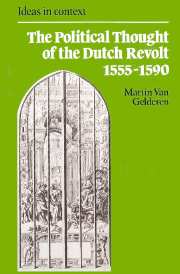Book contents
- Frontmatter
- Contents
- Preface
- List of abbreviations
- 1 Introduction
- 2 The Dutch Revolt: historical contexts
- 3 Religion and resistance: the case of Reformed Protestantism
- 4 Politics and resistance: the political justification of the Dutch Revolt
- 5 From revolt to republic: the quest for the best state of the commonwealth (1578–1590)
- 6 Politics and religion (1572–1590): the debates on religious toleration and the substance of liberty
- 7 Conclusions: the Dutch Revolt and the history of European political thought
- Appendix: a note on primary sources
- Bibliography
- Index
- IDEAS IN CONTEXT
Appendix: a note on primary sources
Published online by Cambridge University Press: 15 December 2009
- Frontmatter
- Contents
- Preface
- List of abbreviations
- 1 Introduction
- 2 The Dutch Revolt: historical contexts
- 3 Religion and resistance: the case of Reformed Protestantism
- 4 Politics and resistance: the political justification of the Dutch Revolt
- 5 From revolt to republic: the quest for the best state of the commonwealth (1578–1590)
- 6 Politics and religion (1572–1590): the debates on religious toleration and the substance of liberty
- 7 Conclusions: the Dutch Revolt and the history of European political thought
- Appendix: a note on primary sources
- Bibliography
- Index
- IDEAS IN CONTEXT
Summary
The interpretation of the political thought of the Dutch Revolt offered in this study is primarily based on the exploration and analysis of treatises published between 1555 and 1590. As the year of Charles V's abdication and Philip II's accession to the throne of Spain and the lordship of the Netherlands, 1555 is an obvious starting-point. As terminus the year 1590 has been chosen. The defeat of the Spanish Armada in 1588, new military initiatives by Maurice of Nassau and the political course under the leadership of Johan van Oldenbarnevelt meant the territorial and political consolidation of what from that time can be called the Dutch Republic.
Focusing on political treatises, the primary sources of this study overwhelmingly consist of printed material. It has become habit to conceive of the political literature of the Revolt in terms of pamphlets. This has been stimulated by the inventory of the collections of main libraries in what was usually called catalogues of pamphlets. Unfortunately, these pamphlet catalogues rarely give any indication of the criteria for listing titles. A simple comparison between them shows that there must have been strong variation on this point. For example, whereas some catalogues of pamphlets list such official government publications as ordinances, resolutions and placards, others do not. The problem is that the term ‘pamphlet’ refers neither to a distinct form of printed material nor to a distinct genre of publication. Craig Harline has defined ‘pamphlets’ as printed ‘writings of immediate and direct or indirect political significance’.
- Type
- Chapter
- Information
- The Political Thought of the Dutch Revolt 1555–1590 , pp. 288 - 290Publisher: Cambridge University PressPrint publication year: 1992

